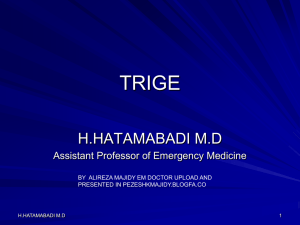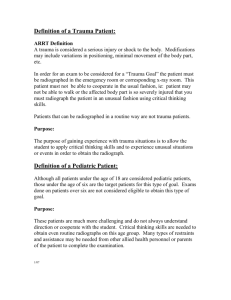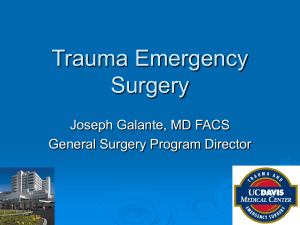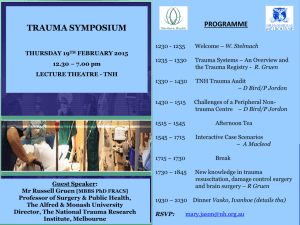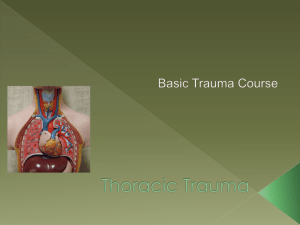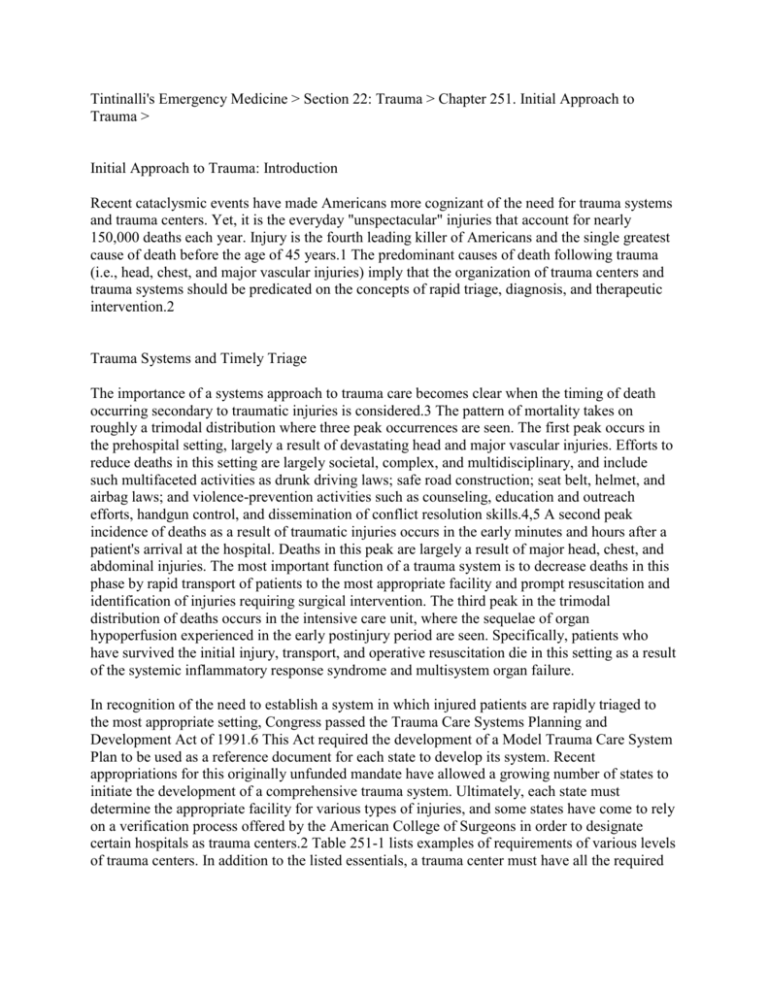
Tintinalli's Emergency Medicine > Section 22: Trauma > Chapter 251. Initial Approach to
Trauma >
Initial Approach to Trauma: Introduction
Recent cataclysmic events have made Americans more cognizant of the need for trauma systems
and trauma centers. Yet, it is the everyday "unspectacular" injuries that account for nearly
150,000 deaths each year. Injury is the fourth leading killer of Americans and the single greatest
cause of death before the age of 45 years.1 The predominant causes of death following trauma
(i.e., head, chest, and major vascular injuries) imply that the organization of trauma centers and
trauma systems should be predicated on the concepts of rapid triage, diagnosis, and therapeutic
intervention.2
Trauma Systems and Timely Triage
The importance of a systems approach to trauma care becomes clear when the timing of death
occurring secondary to traumatic injuries is considered.3 The pattern of mortality takes on
roughly a trimodal distribution where three peak occurrences are seen. The first peak occurs in
the prehospital setting, largely a result of devastating head and major vascular injuries. Efforts to
reduce deaths in this setting are largely societal, complex, and multidisciplinary, and include
such multifaceted activities as drunk driving laws; safe road construction; seat belt, helmet, and
airbag laws; and violence-prevention activities such as counseling, education and outreach
efforts, handgun control, and dissemination of conflict resolution skills.4,5 A second peak
incidence of deaths as a result of traumatic injuries occurs in the early minutes and hours after a
patient's arrival at the hospital. Deaths in this peak are largely a result of major head, chest, and
abdominal injuries. The most important function of a trauma system is to decrease deaths in this
phase by rapid transport of patients to the most appropriate facility and prompt resuscitation and
identification of injuries requiring surgical intervention. The third peak in the trimodal
distribution of deaths occurs in the intensive care unit, where the sequelae of organ
hypoperfusion experienced in the early postinjury period are seen. Specifically, patients who
have survived the initial injury, transport, and operative resuscitation die in this setting as a result
of the systemic inflammatory response syndrome and multisystem organ failure.
In recognition of the need to establish a system in which injured patients are rapidly triaged to
the most appropriate setting, Congress passed the Trauma Care Systems Planning and
Development Act of 1991.6 This Act required the development of a Model Trauma Care System
Plan to be used as a reference document for each state to develop its system. Recent
appropriations for this originally unfunded mandate have allowed a growing number of states to
initiate the development of a comprehensive trauma system. Ultimately, each state must
determine the appropriate facility for various types of injuries, and some states have come to rely
on a verification process offered by the American College of Surgeons in order to designate
certain hospitals as trauma centers.2 Table 251-1 lists examples of requirements of various levels
of trauma centers. In addition to the listed essentials, a trauma center must have all the required
features of lower-level trauma centers. An effective trauma program requires the teamwork of
emergency medicine, trauma surgery, and trauma care subspecialists.
Table 251-1 Essential Characteristics of Levels I, II, III and IV Trauma Centers
Level I (not required of levels II, III, and IV trauma centers)
24-h availability of all surgical subspecialties (including cardiac surgery/bypass capability)
Neuroradiology, hemodialysis available 24 h
Program that establishes and monitors effect of injury prevention/education efforts
Organized trauma research program
Level II (not required of levels III and IV trauma centers)
Cardiology, ophthalmology, plastic surgery, gynecologic surgery available
Operating room ready 24 h a day
Neurosurgery department in hospital
Trauma multidisciplinary quality assurance committee
Level III (not required of level IV trauma centers)
Trauma and emergency medicine services
24-h radiology capability
Pulse oximetry, central venous and arterial catheter monitoring capability
Thermal control equipment for blood and fluids
Published on-call schedule for surgeons, subspecialists
Trauma registry
Level IV
Initial care capabilities only
Mechanism for prompt transfer
Transfer agreements and protocols
In short, trauma centers are verified on the basis of commitment of personnel and resources
needed to maintain a state of readiness to receive critically injured patients. A well-functioning
trauma system ensures that not only are there appropriately designated trauma centers but that
there are also specific triage criteria to designate which patients should be transported to these
centers (Table 251-2).
Table 251-2 Maryland Criteria for Mandatory Transport to a Trauma Center
Abnormal vital signs (GCS <14 or systolic BP <90) (respiratory rate <10 or >29)
Multiple-system trauma
Penetrating wound to
Head, neck, or torso
Gunshot wound(s) to extremities proximal to elbow and knee
An extremity with neurovascular compromise
CNS injury (head, spine)
Suspected pelvic fracture
Mechanism of injury
Vehicular deformity
Intrusion into passenger compartment greater than 12 in
Major vehicular deformity greater than 20 in
Ejection
Entrapment
Falls greater than three times the patient's height
Fatality in same passenger compartment
Rapid deceleration
Auto–pedestrian/auto–bicycle injury with significant impact (>5 mi/h)
Vehicular rollover
Exposure to blast/explosion
Abbreviations: BP = blood pressure; CNS = central nervous system; GCS = Glasgow Coma
Scale.
Source: Adapted from The Maryland Medical Protocols for Emergency Medical Services
Providers. Maryland Institute for Emergency Medical Services Systems, 2003, p 121.
Primary Survey
In accordance with the principles of advanced trauma life support, injured patients are assessed
and treated in a fashion that establishes priorities based on their presenting vital signs, mental
status, and injury mechanism.7 The initial approach to trauma care is a process that consists of an
initial primary assessment, rapid resuscitation, and a more thorough secondary survey followed
by diagnostic tests and ultimate disposition constitutes (Table 251-3).
Table 251-3 A Step-by-Step Procedure for Trauma Resuscitation
1. Notification by Prehospital Personnel: The receiving emergency department should be
informed about:
Airway patency
Pulse and respirations
Level of consciousness
Immobilization
Mechanism of injury and blood loss at the scene
Anatomic sites of apparent injury
2. Preparation for Receiving the Trauma Victim
Assign tasks to team members
Check and prepare vital equipment
Summon surgical consultant and other team members not present
3. Primary Survey: The most immediately lethal injuries are taken care of as they are identified.
Airway
Clear airway: chin lift, suction, finger sweep
Protect airway
Depressed level of consciousness of bleeding, tracheal intubation without neck movement
Surgical airway
Breathing
Ventilate with 100% oxygen
Check thorax and neck
Deviated trachea
Tension pneumothorax (intervention—needle decompression)
Chest wounds and chest wall motion
Sucking chest wound (intervention—occlusive dressing)
Neck and chest crepitation
Multiple broken ribs
Fractured sternum
Pneumothorax
Listen for breath sounds
Correct tracheal tube placement?
Hemopneumothorax?
Chest tube(s)—38-Fr
Collect blood for autotransfusion
Circulation
Apply pressure to sites of external exsanguination
Assure that two large-bore IVs established
Begin with rapid infusion of warm crystalloid solution
If arm sites unavailable, insert a large central line or perform a saphenous cutdown at the
ankle
Assess for blood volume status
Radial and carotid pulse, BP determination
Jugular venous filling
Quality of heart tones
Beck triad present?
Pericardiocentesis or echocardiogram
Decompress tamponade
Pericardiocentesis
Thoracotomy with pericardiotomy
Hypovolemia
After 2 L of crystalloid begin blood infusion if still hypovolemic; in children use two 20mL/kg boluses then 10-mL/kg blood boluses if still unstable
Near-term pregnant patient—place roll under right hip
Disability
Brief neurologic examination
Pupil size and reactivity
Limb movement
Glasgow Coma Scale
Exposure
Completely disrobe the patient
Logroll to inspect back
Continuing resuscitation
Monitor fluid administration
Consider central line for CVP monitoring
Use fetal heart rate as indicator in pregnant women
Record all events
4. Secondary Survey: A thorough search for injuries is carried out in order to set further
priorities.
Trauma series x-rays: lateral cervical spine, supine chest, AP pelvis
Head-to-toe examination looking and feeling; quickly bring problems under control as they are
discovered
Scalp wound bleeding controlled with Raney clips
Hemotympanum?
Facial stability?
Epistaxis tamponaded with balloons if severe
Avulsed teeth, broken jaw?
Penetrating injuries?
Abdominal distention and tenderness?
Pelvic stability?
Perineal laceration/hematoma?
Urethral meatus blood?
Rectal examination for tone, blood, and prostate position
Bimanual vaginal examination
Peripheral pulses
Deformities, open fractures
Reflexes, sensation
Large gastric tube 18-Fr inserted
Foley catheter inserted
Blood?
Pregnancy test
Logroll the patient to feel and see the back, flanks, and buttocks if not already done
Splint unstable fractures/dislocations
Assure that tetanus prophylaxis is given
Consult with surgeon regarding further tests or immediate need for surgery or preferred IV
medications; consider:
Emergency thoracotomy to provide aortic compression of cross-clamping
Aortogram or upright chest x-ray to rule out ruptured aorta
Cystogram if pelvic fracture present or blood in urine
IVP or enhanced CT scan of the abdomen
FAST or diagnostic peritoneal lavage
Head CT scan
IV mannitol for neurologic decompensation
IV steroids for possible spinal cord injury
IV antibiotics for possible ruptured abdominal viscus
IV antibiotics for perineal, vaginal, or rectal lacerations
Pelvic arteriogram and embolization for pelvic hemorrhage
Abbreviations: CVP = central venous pressure; FAST = focused assessment with sonography for
trauma; IVP = intravenous pyelography.
When available, a history obtained from a patient, witnesses, or prehospital provider may
provide important information regarding circumstances of the injury (single-car accident, a fall,
exposure, smoke inhalation), preexisting medical conditions (depression, cardiac disease,
pregnancy), or medications (steroids, -blockers) that may suggest certain patterns of injury or the
physiologic response to injury.
A primary survey is undertaken quickly with the goal of identifying and treating life-threatening
conditions. Specific lethal problems (discussed in further detail below) that should be identified
immediately and addressed during the primary survey are airway obstruction, tension
pneumothorax, massive hemorrhage, open pneumothorax, flail chest, and cardiac tamponade.
The assessment of the ABCs (airway, breathing, and circulation) is such that evidence for or
against the presence of these conditions is sought. During the primary survey, the following are
quickly assessed:
Airway maintenance with C-spine control
Breathing/ventilation
Circulation with hemorrhage control
Neurologic disability
Exposure, where the patient is completely undressed
Some specific points are emphasized regarding the various components of the trauma evaluation.
Airway with Cervical Spine Control
Rapid assessment for airway patency includes inspecting for foreign bodies or maxillofacial
fractures that may result in airway obstruction. The chin-lift or jaw-thrust maneuver or the
insertion of an oral or nasal airway is a first response for the patient making inadequate
respiratory effort. A two-person technique whenever possible is suggested, where one devotes
undivided attention to maintaining in-line immobilization and preventing excessive movement of
the cervical spine. Comatose patients (Glasgow Coma Scale score 3 to 8; see "Disability" below)
should be intubated tracheally to protect the airway and to prevent the secondary brain injury that
occurs with hypoxemia. Logrolling and pharyngeal suction may be necessary to prevent
aspiration if the patient vomits. Patients whose anatomy or severe maxillofacial injury precludes
endotracheal intubation may require a surgical airway by means of cricothyroidotomy. Agitated
trauma patients suffering from head injury, hypoxia, or drug- or alcohol-induced delirium may
present a danger to themselves. In these circumstances, paralyzing agents such as
succinylcholine or vecuronium, along with a small dose of diazepam or midazolam, may be
necessary to enable safe airway management. See Chap. 19 for details, dosages, and techniques.
The issue of cervical spine (C-spine) clearance is one that has received much attention in the
recent past. Ultimately, "clearance" of a C-spine is both a radiologic and a clinical undertaking.
This implies that patients who do not demonstrate evidence of bony fractures or subluxation on
x-ray may still have significant injuries that are not appreciated if they cannot cooperate with a
thorough physical examination. On the other hand, precious time should not be expended on
multiple views in patients who have critical head, thoracic, and abdominal injuries that may
require rapid intervention. In these patients, after a cross-table lateral view of the C-spine, the
cervical collar should be left in place until the patient ultimately can cooperate with the clinical
examination or undergo more sophisticated studies [e.g., computed tomography (CT) scans or
magnetic resonance imaging (MRI) of the spine].
Finally, the practice of obtaining multiple C-spine x-rays in awake, alert patients with normal
examinations (no pain or tenderness with the neck in neutral position and rotated in all four
directions) is excessive. A large multicenter study, the National Emergency X-Radiography
Utilization Study (NEXUS) has helped to develop clinical screening criteria that will spare the
time and expense of cervical films.8 The screening criteria that obviate need for C-spine imaging
are:
1. No posterior midline C-spine tenderness
2. No evidence of intoxication
3. Alert mental status
4. No focal neurologic deficits
5. No painful distracting injuries
In a cohort of 34,069 patients with 578 clinically significant C-spine injuries, these criteria had a
99.6 percent sensitivity and 99.9 percent negative predictive value.
Breathing
With the patient breathing or now intubated and ventilated with 100 percent oxygen, the thorax
and neck should be inspected, auscultated, and palpated to detect abnormalities such as a
deviated trachea (tension pneumothorax); crepitus (pneumothorax); paradoxical movement of a
chest wall segment (flail chest); sucking chest wound; fractured sternum; and absence of breath
sounds on either side of the chest (pneumothorax, tension pneumothorax, massive
pneumothorax). Possible interventions here include application of an occlusive dressing to a
sucking chest wound, needle thoracostomy for tension pneumothorax, withdrawal of the
endotracheal tube from the right mainstem bronchus; reintubation of the trachea if no breath
sounds are heard, and insertion of large chest tubes (38-Fr) to relieve hemopneumothorax.
Evacuated blood should be collected in an autotransfusion device. The volume of blood that
returns should be noted immediately, because 1500 mL of hemorrhage may require a
thoracotomy.
Circulation with Hemorrhage Control
Hemorrhagic shock, a common cause of postinjury death, should be assumed to be present in any
hypotensive trauma patient until proven otherwise. Direct pressure should be used to control
obvious external bleeding, and a rapid assessment of hemodynamic status is essential during the
primary survey. This includes evaluation of level of consciousness, skin color, and presence and
magnitude of peripheral pulses. Attention should be paid to the specifics of heart rate and blood
pulse pressure (systolic minus diastolic blood pressure), particularly in young, previously healthy
trauma patients (Table 251-4).
Table 251-4 Estimated Fluid and Blood Losses Based on Patient's Initial Presentation
Class I Class II Class III Class IV
Blood loss (mL)* Up to 750 750–1500 1500–2000 >2000
Blood loss (percent blood volume) Up to 15 15–30 30–40 40
Pulse rate <100 100–120 120–140 >140
Blood pressure Normal Normal Decreased Decreased
Pulse pressure (mm Hg) Normal or increased Decreased Decreased Decreased
*Assumes a 70-kg patient with a preinjury circulating blood volume of 5 L.
Not all hemorrhage produces hemorrhagic shock, and the unsuspecting clinician may fail to
appreciate ongoing hemorrhage with blood loss of up to 30 percent of the circulating blood
volume.7 While class I hemorrhage (loss of up to 15 percent of circulating blood volume) is
associated with minimal symptoms in most patients and is clearly not shock, class III
hemorrhage associated with gross hypotension is readily appreciated as a state of hypoperfusion.
Yet consider a young, healthy male trauma victim who has lost 25 percent of circulating blood
volume (class II hemorrhage) and had a preinjury blood pressure of 130/70 mm Hg and a pulse
rate of 60 beats/min. If this patient experiences a 50 percent increase in his pulse rate (to a rate of
90 beats/min) and a greater than 50 percent decrement of his pulse pressure (from 130/70 mm Hg
pulse pressure of 60 beats/min to 116/90 mm Hg pulse pressure of 26 beats/min), the
unsuspecting clinician may assume that the patient is "hemodynamically stable." A false sense of
security may lead to delays in aggressively pursuing the source of bleeding (ultrasound,
peritoneal lavage, operative exploration). From this example it should be clear that the practice
of omitting diastolic blood pressures (and reporting "116/palpable," thus omitting the pulse
pressure) is potentially hazardous. The alert, suspicious clinician identifies hemorrhage before it
reaches the class III category of obvious shock.
Two large intravenous lines should be established and blood obtained for laboratory studies.
While there are varying preferences, a percutaneous large line in the groin for unstable patients
in whom upper extremity veins are not available is appropriate. This is so because subclavian
lines are potentially dangerous in the hypovolemic patient with upper body trauma, saphenous
vein cutdown at the ankle may not be appropriate for the patient with an injured lower extremity,
and complications encountered from the femoral venous line may be minimized if the line is
removed quickly on completion of resuscitation in the early postoperative period. Unstable
patients without an obvious indication for surgery should be assessed for their response to 2 L of
rapid infusion of crystalloids. If there is not marked improvement, type O blood should be
transfused (O-negative for females of childbearing age). Auscultation for breath sounds and heart
sounds and inspection of neck veins are included in the assessment of circulation because two
major causes of hypotension may be present in trauma patients with minimal blood loss: cardiac
tamponade (hypotension, agitation, distended neck veins, muffled heart sounds) and tension
pneumothorax (hypotension, distended neck veins, absent breath sounds, deviated trachea,
tympanic percussion of chest wall).
Echocardiography and abdominal ultrasonography, now becoming available in many emergency
departments, are rapid, noninvasive ways to assess for fluid in the pericardium and peritoneal
cavity.9 This allows rapid determination of the bleeding source in the unstable multiply injured
patient.
A discussion of the long-standing controversies involving fluid resuscitation is beyond the scope
of this chapter. However, reference must be made to a landmark paper published by Bickell and
associates.10 In their prospective, randomized study of victims of penetrating torso injuries in
Houston, patients were randomized to receiving immediate intravenous fluid resuscitation versus
withholding fluid until operative intervention could be undertaken. A lower mortality was
identified among the group with delayed fluid resuscitation, prompting the authors to speculate
that giving fluids before operative control could be achieved is harmful. However one interprets
this study, the fact that there were inordinate delays (sometimes >50 min) between hospital
arrival and surgical intervention should help achieve consensus around at least one concept: the
importance of rapid triage of critically injured patients, particularly those with penetrating
trauma, to an appropriate trauma center. One is hard-pressed to identify any beneficial
interventions that would justify a delay in rapid transport.
The inability, after nearly three decades, to demonstrate an unequivocal advantage of colloid
therapy (which is more expensive than crystalloids) has led to near-universal acceptance of a
balanced salt crystalloid (NS or LR) as the fluid of choice for initial resuscitation.
Disability
An abbreviated neurologic evaluation should now be performed, including level of
consciousness, pupil size and reactivity, and motor function. The Glasgow Coma Scale (GCS)
(see Table 255-2) should be used to quantify the patient's level of consciousness: possible scores
range from 3 (no response) to 15 (high response on all measures). Despite the common comorbid
presence of drug and alcohol abuse in trauma patients, it is only safe to assume that patients
presenting with a GCS score of less than 15 and an appropriate mechanism have a head injury
until proven otherwise. The GCS can be used to determine the severity of injury (minor injury
GCS 13 and 14, moderate injury GCS 9 to 12, severe injury–coma GCS 3 to 8) and therefore the
urgency with which the CT scan is obtained. New head injury guidelines have been formulated
by an evidence-based methodology performed by the Brain Trauma Foundation in conjunction
with the American Association of Neurological Surgeons.11,12 Among the updated
recommendations are 1) a suggested guideline for the placement of devices for intracranial
pressure (ICP) monitoring for head-injured patients with GCS scores of 3 to 8 and a traumatic
intracranial lesion and 2) concerns about prolonged prophylactic hyperventilation in the absence
of an identified increase in ICP. The result of these two recommendations produces a heightened
emphasis on the importance of the head CT scan. Only a head CT scan would identify the
intracranial lesion that would lead to placement of an ICP catheter, and it is only with
identification of such an increase in ICP that prolonged hyperventilation (until recently a practice
routinely taught) can be justified. Accordingly, patients who are comatose after head injury
should be intubated with in-line neck immobilization and transported to the CT scanner with the
same sense of urgency that a hypotensive patient with a gunshot wound to the abdomen would be
rushed to the operating room.
Exposure
No primary survey is complete without thoroughly disrobing the patient and examining the total
body surface area carefully for otherwise hidden bruises, lacerations, impaled foreign bodies, and
open fractures. If hemodynamically stable and if the airway is ensured, the patient should be
logrolled, with one attendant assigned to maintain cervical stabilization. Check the back and
thoracic and lumbar spine for tenderness. Check the gluteal cleft and perineum for injury. When
the examination is completed, the patient should be covered with warm blankets to prevent
hypothermia.
When derangements in any of the components of the primary survey are identified, treatment is
undertaken immediately. Once the primary survey is complete, securing of the airway,
intravenous catheters as well as urinary and gastric catheters, and monitors should be achieved.
At this point a secondary survey, a more thorough head-to-toe evaluation, is undertaken. It
should be stressed that the secondary survey is not initiated until the primary survey (ABCs) is
assessed to be adequate and resuscitation has been initiated.
Specific Injuries of Importance
Having discussed the initial assessment of the injured patient, emphasis is placed on specific
injuries of importance. These injuries are critical in that they are identified during the primary
survey, represent impending demise, and require an immediate response.
Traumatic Arrests
In most emergency medical systems, paramedics transport patients without vital signs to a
hospital while CPR is initiated (unless obvious signs of death are present). On arrival to the ED,
a critical decision must be made regarding the level of intervention. A series analyzing 862
patients undergoing ED thoracotomy at a regional trauma center yields interesting
information.13 The overall number of neurologically intact survivors was 3.9 percent. Among
patients with blunt trauma and no vital signs in the field there were no survivors. This is a
consistent finding among other series, and clearly ED thoracotomy for this group of patients
should be abandoned. The greatest proportion of neurologically intact survivors was among
patients with stab wounds to the chest. Further analysis revealed that survival rate was 23 percent
among thoracic stab wound victims with vital signs in the field, and 38 percent among those who
were moribund but had some vital signs on arrival to the ED. Therefore, the strongest
recommendation for ED thoracotomy can be made for victims with penetrating chest trauma
with witnessed signs of life in transport or in the ED and at least cardiac electrical activity on
arrival.13–15 More liberal indications (although not with total consensus) would include victims
with abdominal trauma with cardiac electrical activity, in whom thoracotomy is performed for
resuscitation and aortic cross-clamping before operating room laparotomy (rather than for
hemorrhage control), and patients with blunt torso trauma who have some vital signs on arrival.
Patients with blunt trauma and absent vital signs or sign of life on arrival should not undergo
thoracotomy.
Severe Head Trauma
Head trauma with coma (GCS 3 to 8) suggests that rapid assessment of the intracranial injury
must be undertaken and the patient should be intubated for airway protection and to avoid
secondary brain injury associated with hypoxemia. These patients present a dilemma, because
ultimately they may be found to have anything ranging from a normal head CT scan to a
devastating, nonsurvivable brain injury. The challenge is to quickly identify patients with
intracranial injuries that may benefit from neurosurgical evacuation. In such cases, minutes may
make a difference in the ultimate patient outcome. Accordingly, all nonessential procedures (i.e.,
those that do not address a problem discovered during the primary survey) should be prioritized
to a time after the head CT is performed. The patient is intubated with in-line neck
immobilization, and the C-spine collar is reapplied. A rapid chest x-ray may be justifiable to
exclude pneumothorax and to assess endotracheal tube placement, particularly if the film can be
developed as the patient is being transported to the CT scan suite. This implies that in the wellrun trauma center the critically multisystem-injured patient has ongoing diagnostic workup and
therapeutic resuscitation occurring in a smooth transition between ED, x-ray suite, operating
room, and postoperative intensive care setting.
Tension Pneumothorax, Open Pneumothorax, and Massive Hemothorax
These are all diagnoses that should be made during the primary survey and subsequently require
rapid placement of a chest tube. Absent breath sounds on the side of a gunshot wound, stab
wound, or chest wall ecchymosis (associated with tympany in the case of pneumothorax and
percussion dullness in the case of hemothorax) in a patient with respiratory distress and
tachycardia suggest the diagnosis. These are discussed in detail in Chap. 259.
Abdominal Gunshot Wounds with Hypotension
This deserves special mention. Palpation tenderness elicited on ED admission identifies the need
for surgery and should prompt immediate transport to the operating room without further
workup. Placement of nasogastric, urinary, and intravenous catheters should proceed in the
operating room as the patient is being prepared for general anesthesia. The importance of time is
emphasized because of the large amount of hemorrhage necessary (>2 L in the 70-kg patient) to
produce severe hypotension in a young, previously healthy patient.7 A false sense of security
with these patients brought on by the absence of hypotension is hazardous.
Deeply Impaled Objects
Deeply impaled objects of the chest and abdomen should be left in situ and the patient rapidly
transported to the operating room for surgical removal under direct vision to ensure
hemostasis.16 The object can be shortened to facilitate transport.
Secondary Survey
While resuscitation continues, a secondary survey should be undertaken. The secondary survey is
a rapid but thorough physical examination for the purpose of identifying as many injuries as
possible. With this information, the resuscitating physician and his or her surgical colleagues can
set logical priorities for evaluation and management. Frequent assessments of the patient's blood
pressure, pulse rate, and central venous pressure should continue.
The examination is conducted in a head-to-toe fashion, beginning with the scalp. Scalp
lacerations can bleed profusely. This bleeding can be controlled with plastic Raney clips that
grasp the full thickness of the scalp and galea. The tympanic membranes should be visualized to
detect hemotympanum, and the pupil examination should be repeated. If epistaxis is a problem, a
balloon-tipped urinary catheter or a nasal balloon should be inserted to provide posterior
tamponade. The examination continues over the neck and thorax. A lateral cervical spine x-ray
(if not already obtained), a chest x-ray, and an anteroposterior pelvic x-ray should be obtained
while the secondary survey continues. A gastric tube should be inserted into the stomach and
connected to suction. When there is facial trauma or basilar skull fracture, the gastric tube should
be inserted through the mouth rather than the nose. The urinary meatus, scrotum, and perineum
are inspected for the presence of blood, hematoma, or laceration.
A rectal examination is done, noting sphincter function and whether the prostate is boggy or
displaced. Rectal blood should be noted. If the prostate is normal and there is no blood at the
urethral meatus, a urinary drainage catheter can be placed in the bladder. If a urethral injury is
suspected (meatal blood present), a urethrogram should be obtained prior to passing the catheter.
If the prostate is displaced, it should be assumed that the urethra is disrupted. Catheterization
should not be attempted if the urethra is injured. The urine should be examined for blood. If the
patient is a woman of childbearing age, a pregnancy test should be obtained. If there is vaginal
bleeding, a manual and speculum examination is necessary to identify a possible vaginal
laceration in the presence of a pelvic fracture. Palpate all peripheral pulses. The patient should be
logrolled to either side while keeping the neck immobilized so that every inch of the patient's
body is seen and felt. The extremities should be evaluated for fracture and soft tissue injury.
Peripheral pulses should be felt. A more thorough neurologic examination can now be done,
carefully checking motor and sensory function.
There are many conditions that may be delayed or not evident during the secondary survey
unless specifically sought. The secondary survey should be directed toward evidence of the
presence or absence of the following conditions: tracheal disruption, aortic disruption,
esophageal disruption, pulmonary contusion, cardiac contusion, and diaphragmatic hernia. The
latter five are discussed in Chap. 259.
Some of these are not evident even with diligent search during the secondary survey. Vigilance
should be maintained during the ED visit, observation period, and any subsequent hospital stay
for delayed presentations. Although usually not life-threatening, missed conditions are most
likely to be orthopedic in nature. Careful consideration of extremity orthopedic injuries can be
easily overlooked in patients whose presentations require a multitrauma evaluation.
Radiographic Imaging
In patients who are not rapidly transported to the operating suite or the CT scanner after the
initial assessment, standard radiographic imaging includes lateral C-spine, chest, and pelvic
radiographs. The chest x-ray and pelvic films image the three regions (left hemithorax, right
hemithorax, and extraperitoneal pelvis) outside the true peritoneal cavity that can accommodate
volumes of hemorrhage sufficient to produce gross hypotension. X-rays in penetrating trauma
are dictated by bullet entry site and include a chest x-ray for patients with torso penetrating
trauma and appropriate extremity films to exclude fractures in patients with penetrating
extremity injuries.
Echocardiography has become a useful diagnostic tool for emergency physicians and trauma
surgeons.17 A focused abdominal sonographic examination for trauma (FAST) is a rapid
diagnostic tool performed with a 3.5-MHz transducer that assesses for fluid in 1) the
pericardium, 2) the hepatorenal recess of Morrison (a common location for blood in patients with
hemoperitoneum), 3) the pelvis around the bladder, and 4) the perisplenic region. Abdominal
sonography in the trauma patient is rapidly supplanting diagnostic peritoneal lavage as the
procedure of choice to detect hemoperitoneum in the unstable trauma patient for whom transport
to the CT suite is unsafe.9
Disposition
Options include moving the patient to the operating room, admission to the hospital, or transfer
to another facility. The primary and secondary survey must have been completed, and a gastric
tube and a urinary drainage catheter should be in place unless a urethral injury was detected. In
most urban level I hospitals, the trauma surgeon should have been present for the secondary
survey and should assume direction of the diagnostic workup and disposition of the case at that
time. In rural hospitals that transfer severe trauma cases, the resuscitating physician should relate
all the physical findings discovered during the primary and secondary surveys to the physician
receiving the patient. Laboratory results, x-rays, and the flow sheet showing blood pressure,
pulse, fluids infused, urine output, gastric output, and neurologic findings should accompany the
patient. If a diagnostic peritoneal lavage was performed, a sample of the lavage fluid should
accompany the patient. A patient who is being transported to another facility should be
accompanied by personnel capable of administering fluids and monitoring vital signs and
pupillary changes. Mannitol should be available if there is neurologic deterioration en route.
The hallmark of trauma care in patients without obvious indications for surgery identified on the
initial assessment is serial examination. An observation area is extremely useful for these
patients. Such an area (typically with nursing care provisions analogous to those of an
intermediate care unit in most hospitals) allows for serial observations of 1) patients with closed
head trauma who have regained consciousness but who require repeat neurologic examinations;
2) patients with penetrating abdominal wounds (stab wounds or tangential gunshot wounds) who
require repeat abdominal examinations; 3) patients receiving repeat chest x-rays for penetrating
chest trauma without pneumothoraces; 4) patients with blunt abdominal trauma with normal
physical examination on initial evaluation; and 5) patients with documented blunt injuries to the
liver, spleen, or kidney who are clinically stable and are being managed nonoperatively. An
observation area for these patients should allow for more rapid triage from the ED and for serial
evaluations of multiple patients in a convenient setting and should provide for rapid transport to
the operating room in patients whose clinical examination deteriorates.
References
1. Committee on Injury Prevention and Control Division of Health Promotion and Disease
Prevention, in Bonnie RJ, Fulco CE, Liverman CT (eds): Reducing the Burden of Injury.
Advancing Prevention and Treatment. Washington, DC: National Academy Press, 1999.
2. American College of Surgeons Committee on Trauma: Resources for Optimal Care of the
Injured Patient: 1999. Chicago: American College of Surgeons, 1998.
3. Mann NC, Mullins RJ, MacKenzie EJ, et al: Systematic review of published evidence
regarding trauma system effectiveness. J Trauma 47:S25, 1999.
4. Cornwell EE III, Jacobs D, Walker M, et al: National Medical Association Surgical Section:
Position paper on violence prevention: A resolution of trauma surgeons caring for victims of
violence. JAMA 273:1788, 1995. [PMID: 7769775]
5. Cornwell EE III, Berne TV, Belzberg H, et al: Health care crisis from a trauma center
perspective: The L.A. story. JAMA 276(12):940, 1996.
6. General Accounting Office: Trauma Care: Life-Saving System Threatened by Unreimbursed
Costs and Other Factors. Report to the Chairman, Subcommittee on Health for Families and the
Uninsured, Committee on Finance, U.S. Senate. Washington, DC: GAO (HRD-91-57), 1991.
7. American College of Surgeons Committee on Trauma: Advanced Trauma Life Support for
Doctors, Instructor Course Manual, 6th ed. Chicago: American College of Surgeons, 1997.
8. Hoffman JR, Mower WR, Wolfson AB, et al: Validity of a set of clinical criteria to rule out
injury to the cervical spine in patients with blunt trauma. New Engl J Med 343:343, 2000.
9. McKenney GS, Ochsner MG, Schmidt JA, et al: Can ultrasound replace diagnostic peritoneal
lavage in the assessment of blunt trauma? J Trauma 37:439, 1994. [PMID: 8083906]
10. Bickell WH, Wall MJ Jr, Pepe PE, et al: Immediate versus delayed fluid resuscitation for
hypotensive patients with penetrating torso injuries. New Engl J Med 331:1105, 1994. [PMID:
7935634]
11. Brain Trauma Foundation: Indications for intracranial pressure monitoring. J Neurotrauma
13:667, 1997.
12. Brain Trauma Foundation: The use of hyperventilation in the acute management of severe
traumatic brain injury. J Neurotrauma 13:699, 1997.
13. Branney SW, Moore EE, Feldhaus KM, Wolfe RE: Critical analysis of two decades of
experience with postinjury emergency department thoracotomy in a regional trauma center. J
Trauma 45(1):87, 1998.
14. Esposito TJ, Jurkovich GJ, Rice CL, et al: Reappraisal of emergency room thoracotomy in a
changing environment. J Trauma 31:881, 1991. [PMID: 2072424]
15. Velmahos GC, Degiannis E, Souter I, et al: Outcome of a strict policy on emergency
department thoracotomies. Arch Surg 130:774, 1995. [PMID: 7611869]
16. Cartwright AJ, Taams KO, Unsworth-White MJ, et al: Suicidal nonfatal impalement injury
of the thorax. Ann Thorac Surg 72:1364, 2001. [PMID: 11603463]
17. Rozycki GS, Ochsner MG, Frankel HL, et al: A prospective study of surgeon-performed
ultrasound as the initial diagnostic modality for injured patient assessment. J Trauma 39:492,
1995. [PMID: 7473914]
Copyright © The McGraw-Hill Companies. All rights reserved.
Privacy Notice. Any use is subject to the Terms of Use and Notice.

